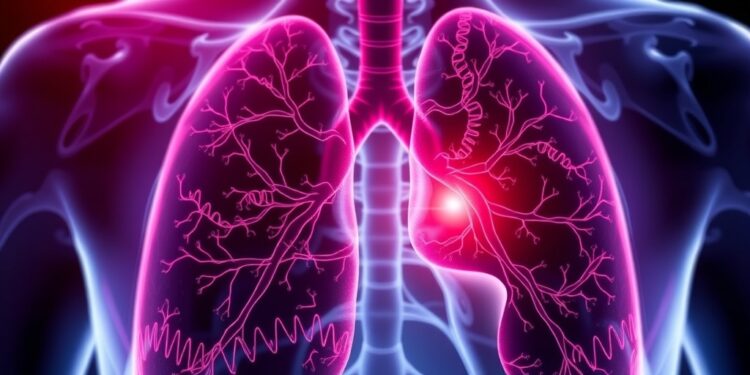In a groundbreaking study, researchers from the University of Cambridge have revealed that the genetic underpinnings of a punctured lung, also known as pneumothorax, may be more widespread than previously understood. Their research indicates that approximately one in 3,000 individuals harbors a faulty variant of the FLCN gene, which is associated with Birt-Hogg-Dubé syndrome—a genetic disorder characterized by distinct symptoms such as benign skin tumors, lung cysts, and an elevated risk of kidney cancer. This discovery greatly contrasts with earlier assessments that placed the risk of carrying such a gene at one in 200,000.
The FLCN gene serves as a critical component in cellular homeostasis and cancer suppression. When mutated, it leads to the aforementioned syndrome, and its impact on health is far-reaching. In their extensive study, the Cambridge team analyzed massive genomic datasets, including data from the UK Biobank, the 100,000 Genomes Project, and East London Genes & Health, comprising over 550,000 individuals. This breadth of data allowed researchers to uncover a more precise prevalence of the genetic variant linked to Birt-Hogg-Dubé syndrome.
Interestingly, while individuals diagnosed with Birt-Hogg-Dubé syndrome face a lifetime risk of pneumothorax as high as 37%, the broader population of carriers of the FLCN mutation has a slightly lower risk at 28%. Moreover, the risk of developing kidney cancer dramatically differs between these two groups; only 1% of undiagnosed FLCN carriers develop the disease, compared to 32% of those with the syndrome. This discrepancy highlights the complexity of genetic expressions and raises important questions about the role of additional genetic backgrounds in modulating disease severity.
Pneumothorax occurs when air leaks into the space surrounding the lungs, leading to painful lung deflation and a sensation of breathlessness. Many cases, particularly among tall, thin young males aged in their teens and early twenties, are spontaneous and often resolve without surgical intervention. The management of such cases typically includes monitoring and outpatient procedures, with many individuals remaining unaware of their condition.
For those who experience a pneumothorax outside the expected demographic—or who encounter recurrent occurrences—the presence of tell-tale cysts observed via MRI scans can indicate the underlying presence of Birt-Hogg-Dubé syndrome. Early diagnosis is crucial, as the syndrome’s association with kidney cancer amplifies the stakes involved in monitoring and patient management.
Professor Marciniak, a leading researcher within the study, underscores the importance of diagnosis. Individuals with Birt-Hogg-Dubé syndrome not only face risks of lung complications but must also recognize their potential predisposition to developing kidney cancer. Fortunately, the timeline of developing kidney cancer often follows years after the initial occurrence of pneumothorax symptoms, allowing healthcare providers to implement regular screening to catch any tumors when they are still manageable.
Surprisingly, Professor Marciniak also notes the study’s finding that carriers of the faulty FLCN gene without Birt-Hogg-Dubé syndrome do not share the same elevated kidney cancer risk. This suggests that while the gene’s defect is a critical factor, other genetic interactions might also be involved in the complex pathology of the syndrome and its associated risks. This revelation adds a layer of intrigue to genetic research, as it challenges the notion of gene isolation in disease causation.
As genetic testing grows increasingly common, the study ignites a crucial conversation about the implications of discovering individuals with mutations tied to conditions like Birt-Hogg-Dubé syndrome. However, Professor Marciniak reassures that unless individuals exhibit the hallmark signs of the syndrome, routine kidney cancer screenings may not be necessary. Instead, reliance on comprehensive genetic evaluations and symptomatic indicators is essential.
This research caught attention not only for its implications regarding pneumothorax but for the broader understanding of genetic predispositions to a variety of conditions. As genetic science continues to evolve, understanding the interplay between inherited mutations and environmental factors will undoubtedly guide future explorations in both treatment and prevention.
The study, backed by funding from the Myrovlytis Trust and additional support from the National Institute for Health and Care Research Cambridge Biomedical Research Centre, opens new pathways for understanding familial health patterns. It calls for more delineated research into genetic syndromes that may have previously escaped the collective scientific radar.
Such findings highlight the thrilling advances in genetics and medicine, underlining a significant need for collaborative approaches in research that can impact patient care. As scientists forge ahead, this study is poised to influence our understanding and management of hereditary conditions significantly.
In summary, the discovery of a much higher frequency of a risky genetic variant associated with pneumothorax offers fresh critiques and avenues for future research, elevating our comprehension of genetic diseases and their wider implications on health.
Subject of Research: Individuals with Birt-Hogg-Dubé syndrome and carriers of the FLCN gene mutation.
Article Title: Inherited predisposition to pneumothorax: Estimating the frequency of Birt-Hogg-Dubé syndrome from genomics and population cohorts.
News Publication Date: 8-Apr-2025.
Web References: DOI Link.
References: Yngvadottir, B et al. Thorax; 8 April 2025; DOI: 10.1136/thorax-2024-221738.
Image Credits: University of Cambridge.
Keywords: Genetics, Birt-Hogg-Dubé syndrome, pneumothorax, kidney cancer, FLCN gene.




